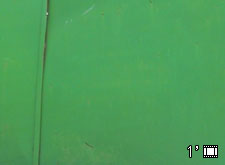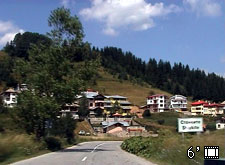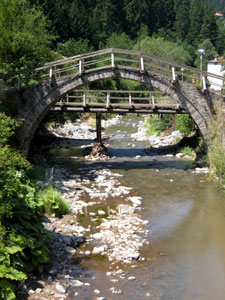It makes me feel quite at home, though few new churches are being opened in Scotland except in reincarnation — having been deconsecrated — supermarkets, private dwellings etc. In fact when I google ‘new churches Scotland’ the first thing I get is a nostalgia entry from a 1906 newspaper for a church which had sold its old premises to a railway company, commissioned larger premises and managed  to save 25% of the purchase price into the bargain. Instead of 450, it would now be able to seat 1,000 (it is still there). to save 25% of the purchase price into the bargain. Instead of 450, it would now be able to seat 1,000 (it is still there).
It’s hot, but there is a wind coming down the valley and, after we have been inside the observatory, we walk around it. At the back there is a temporary metal door opening and closing of its own accord.
Down at the river we see one of these elegant, stone-arched bridges, a quotidian version of the bridge at Mostar and related to the squatter stone bridges over the rivers in the highlands of Scotland, built by the English army in the aftermath of the Stuart rebellion of 1745 to enable it to move faster over the territory and thus establish control over rebellious highlanders.
We then head back up into the hills, in the general direction of Devin, joining the valley of the Shirokolashka at Stoykite and going on to the village of Shiroko Laka with many of its houses from the National Revival period (which generally seems to refer to the period from 1820–78). One of them has been turned into a museum. The most interesting thing about small museums like this is the feeling one gets for the living space that people inhabited, what the architecture requires of a modern body say, compared to one from 120 years ago.
|
|
Suggestions of smaller people but also  more emphasis on keeping the outside world(heat, cold and politics) on one side of the walls and friends, warmth and political secrets on the other. more emphasis on keeping the outside world(heat, cold and politics) on one side of the walls and friends, warmth and political secrets on the other.
We are en route for the Orphic cave at Yagodina. One of the simple but illuminating things we’ve heard is th e statement “…and Orpheus was a Bulgarian too…”. On the surface it is a fairly straightforward claim but the implications are manifold. One aspect is that it shifts Orpheus out of the ‘Greek’ myths into a more volatile territory, one that not only concerned the relationships of the older ethnic groups of the Balkans to each other but is also relevant to destabilising the Western European construction of Greece too. e statement “…and Orpheus was a Bulgarian too…”. On the surface it is a fairly straightforward claim but the implications are manifold. One aspect is that it shifts Orpheus out of the ‘Greek’ myths into a more volatile territory, one that not only concerned the relationships of the older ethnic groups of the Balkans to each other but is also relevant to destabilising the Western European construction of Greece too.
According to one version of the legend Orpheus was a Thracian prince and part of historical Thrace is now Bulgaria, therefore… The Greeks on the other hand have been complaining about the Bulgarian usurpation of one of ‘their’ heroes. There are a number of interesting issues here. In the first place what is actually central is not so much the historical accuracy of the claims as such but their value in marketing ‘Orpheus’ brand heritage in the tourist trade. |